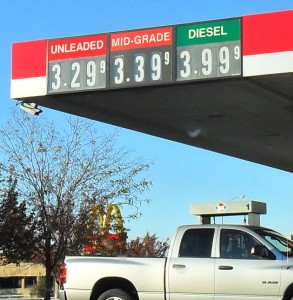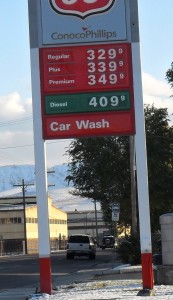I was upset by a Memorial Day report on one of the mainstream U.S. national TV news programs, ’cause they reported gas prices down across the country! Wait a minute, I live in the United States and gas prices actually went up where I live!
I noted that the mainstream media report focused only on the eastern half of the United States. I checked the internet for reports concerning the western half, and sure enough fuel prices have been going up here!
In the Pacific Northwest U.S. state of Idaho gas prices average $3.64 USD, according to the American Automobile Association (AAA). But here in eastern Idaho it’s more like $3.77 per gallon. In Mackay (pronounced Mac-Key), Idaho, it’s $3.90.
In the U.S. state of California prices are more than $4.00 per gallon. Gas prices have not come down in the past few weeks, even though oil prices have!
What’s going on? Why have fuel prices come down in the eastern half of the U.S. and, in some cases, actually gone up in the western half?
For one, the eastern half has a glut of oil, from the fields in the U.S. state of North Dakota, and from the northern country of Canada. However, in recent months there was a lot of predictions that fuel prices would actually go up for the eastern half of the U.S., because several major refineries were being permanently shut down.
Two of those refineries are located in the U.S. state of Pennsylvania. Fears of skyrocketing fuel prices turned to joy when it was revealed, towards the end of April, that Delta Airlines and Energy Transfer Partners will buy those refineries, and keep them up and running!
Also at the end of April, it was revealed that a new refinery, also in Pennsylvania, was up and running on the Delaware River! It’s primary source of oil is shale oil from North Dakota and Texas. This is important because it turns out that many of the older refineries can not handle refining shale oil.
Another important fact is that finally new oil pipelines are opening up, helping to get that bottlenecked glut of oil in North Dakota, and from Canada, down to refineries along the Gulf of Mexico, and to ports in Portland, Maine.
Finally, there was a recent report that a new diesel fuel refinery will be built near Williston, North Dakota!
So what’s happening in the western half of the U.S.?
On 22 May it was reported that U.S. oil supplies were at a 21 year high. However, when you look at refined gasoline and break it down between eastern and western U.S. you get a different picture, because you’ll see that having a lot of oil does not translate into having a lot of gasoline.
The very next day, 23 May, the U.S. Department of Energy (DOE) released a report which stated: “PADD 5 gasoline inventories at 24.1 million barrels on May 18, about 5.1 million barrels (17 percent) below typical levels for that date, the lowest for the region since March 1999.”
The DOE explained: “Abnormally low refinery runs on the West Coast since February tightened local gasoline markets, causing both wholesale and retail gasoline prices to rise.”
The DOE blamed reduced fuel supply to the western U.S. on that fact that several refineries were shut down for maintenance. One of those refineries, British Petroleum’s Cherry Point, in the U.S. state of Washington, should be re-starting.
The DOE also explained that the western half of the U.S. sees higher fuel prices because of a lack of pipelines: “While unplanned refinery outages generally cause retail product prices to rise, the West Coast market is especially sensitive to such shutdowns. That is because the West Coast market is relatively isolated. Given the West Coast’s lack of significant pipeline connections to other markets and relative distance from the active physical trading markets….”
According to the DOE, it takes six weeks for any change in the price per barrel of oil plus any shortage or surplus of refined fuel, to be reflected in western U.S. fuel prices at the pump, but, if there are no further interruptions in western refinery operations prices should start coming down.

